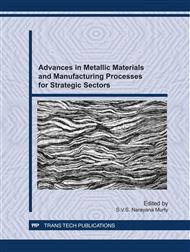p.326
p.332
p.338
p.347
p.353
p.359
p.365
p.371
p.377
Fabrication and Optimization of Drilling Parameters in Heat Treated SiC Reinforced Functionally Graded Al Composites Using Taguchi Method
Abstract:
The present investigation is on the fabrication of SiC particles reinforced aluminum functionally graded disc and optimization of drilling process parameters using Taguchi method. The primary processing of A356-20%SiCp composite have been carried out by liquid metal stir casting technique followed by centrifugal casting leading to the formation of a functionally graded Al FGM disc with SiC particles segregating towards the outer periphery of the casting. The composite specimens are heat treated and used for the drilling studies. Taguchi method has been used to find the optimal drilling parameters for surface roughness and thrust force during drilling. The Taguchi Orthogonal arrays, signal-to-noise ratio (S/N) and Analysis of variance (ANOVA) are employed to study the performance characteristics in drilling operations of FGMMC using TiAlN coated carbide tools. The drilling parameters like cutting speed, feed and point angle in three different zones (15, 45, and 75 mm from the outer periphery) of FGMMC are optimized with considerations of surface roughness and thrust force.
Info:
Periodical:
Pages:
353-358
Citation:
Online since:
January 2012
Authors:
Price:
Сopyright:
© 2012 Trans Tech Publications Ltd. All Rights Reserved
Share:
Citation:


